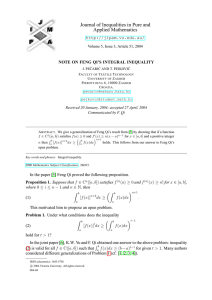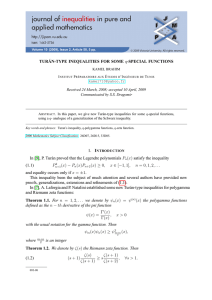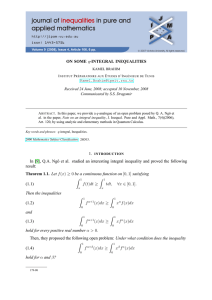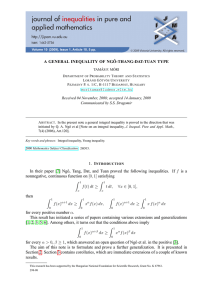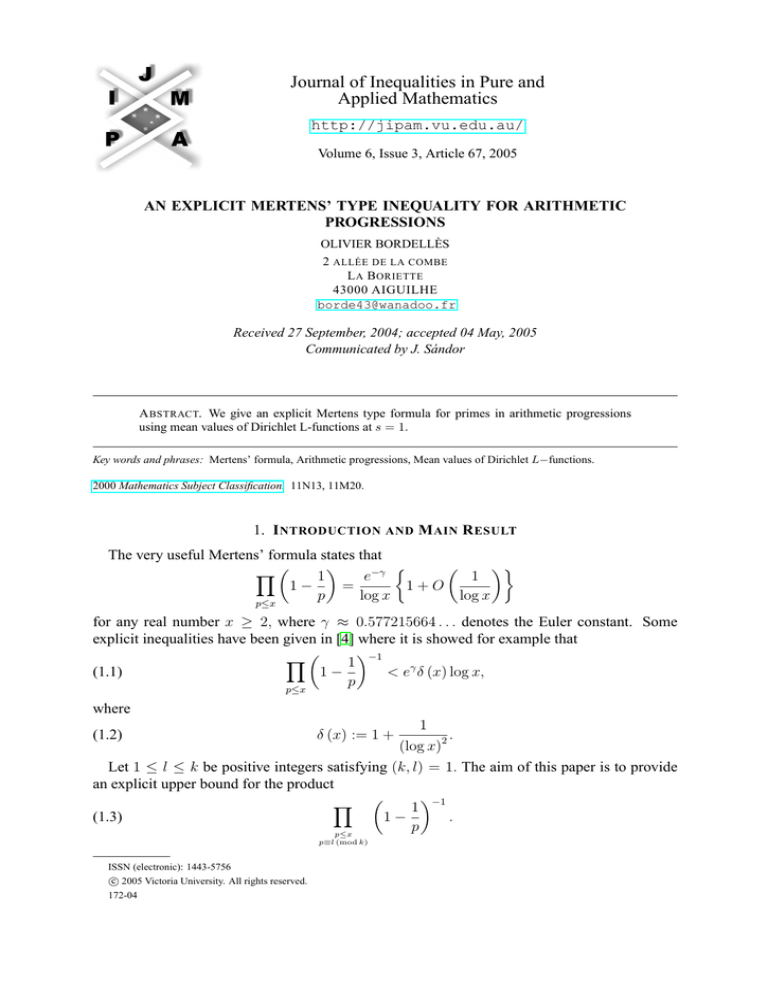
Journal of Inequalities in Pure and
Applied Mathematics
http://jipam.vu.edu.au/
Volume 6, Issue 3, Article 67, 2005
AN EXPLICIT MERTENS’ TYPE INEQUALITY FOR ARITHMETIC
PROGRESSIONS
OLIVIER BORDELLÈS
2 ALLÉE DE LA COMBE
L A B ORIETTE
43000 AIGUILHE
borde43@wanadoo.fr
Received 27 September, 2004; accepted 04 May, 2005
Communicated by J. Sándor
A BSTRACT. We give an explicit Mertens type formula for primes in arithmetic progressions
using mean values of Dirichlet L-functions at s = 1.
Key words and phrases: Mertens’ formula, Arithmetic progressions, Mean values of Dirichlet L−functions.
2000 Mathematics Subject Classification. 11N13, 11M20.
1. I NTRODUCTION AND M AIN R ESULT
The very useful Mertens’ formula states that
Y
1
e−γ
1
1−
=
1+O
p
log
x
log x
p≤x
for any real number x ≥ 2, where γ ≈ 0.577215664 . . . denotes the Euler constant. Some
explicit inequalities have been given in [4] where it is showed for example that
−1
Y
1
(1.1)
1−
< eγ δ (x) log x,
p
p≤x
where
(1.2)
δ (x) := 1 +
1
.
(log x)2
Let 1 ≤ l ≤ k be positive integers satisfying (k, l) = 1. The aim of this paper is to provide
an explicit upper bound for the product
−1
Y 1
(1.3)
1−
.
p
p≤x
p≡l (mod k)
ISSN (electronic): 1443-5756
c 2005 Victoria University. All rights reserved.
172-04
2
O LIVIER B ORDELLÈS
In [2, 5], the authors gave asymptotic formulas for (1.3) in the form
Y 1
1−
∼ c (k, l) (log x)−1/ϕ(k) ,
p
p≤x
p≡l (mod k)
where ϕ is the Euler totient function and c (k, l) is a constant depending on l and k. Nevertheless,
because of the non-effectivity of the Siegel-Walfisz theorem, one cannot compute the implied
constant in the error term. Moreover, the constant c (k, l) is given only for some particular cases
in [2], whereas K.S. Williams established a quite complicated expression of c (k, l) involving a
product of Dirichlet L−functions L (s; χ) and a function K (s; χ) at s = 1, where K (s; χ) is
the generating Dirichlet series of the completely multiplicative function kχ defined by
(
−χ(p) )
χ (p)
1
kχ (p) := p 1 − 1 −
1−
p
p
for any prime number p and any Dirichlet character χ modulo k. The author then gave explicit
expressions of c (k, l) in the case k = 24.
It could be useful to have an explicit upper bound for (1.3) valid for a large range of k and x.
Indeed, we shall see in a forthcoming paper that such a bound could be used to estimate class
numbers of certain cyclic number fields. We prove the following result:
Theorem 1.1. Let 1 ≤ l ≤ k be positive integers satisfying (k, l) = 1 and k ≥ 37, and x be a
positive real number such that x > k. We have:
v
1
−1
γ
ϕ(k)
u
Y Y
1
e ϕ (k)
1
2(γ−B) u
tζ (2)
1−
<e
log x
· Φ (x, k) ,
1− 2 ·
p
p
k
p≤x
p|k
p≡l (mod k)
where
(
Φ (x, k) := exp
!)
√
√
2 k log k X L 0
(1; χ) + 2 k log k + E − γ
,
ϕ (k) χ6=χ L
2
log x
0
B ≈ 0.261497212847643 . . . and E ≈ 1.332582275733221 . . .
The restriction k ≥ 37 is given here just to use a simpler expression of the Polyá-Vinogradov
inequality, but one can prove a similar result with k ≥ 9 only, the constants in Φ (x, k) being
slightly larger.
2. N OTATION
p denotes always a prime, 1 ≤ l ≤ k are positive integers satisfying (k, l) = 1 and k ≥ 37,
x > k is a real number,
!
n
X
1
γ := lim
− log n ≈ 0.5772156649015328 . . .
n→∞
k
k=1
is the Euler constant and
γ1 := lim
n→∞
n
X
log k
k=1
k
(log n)2
−
2
!
≈ −0.07281584548367 . . .
is the first Stieltjes constant. Similarly,
E := lim
n→∞
log n −
J. Inequal. Pure and Appl. Math., 6(3) Art. 67, 2005
X log p
p≤n
p
!
≈ 1.332582275733221 . . .
http://jipam.vu.edu.au/
A M ERTENS ’ INEQUALITY FOR A RITHMETIC
and
B := lim
n→∞
X1
p≤n
p
3
PROGRESSIONS
!
− log log n
≈ 0.261497212847643 . . .
χ denotes a Dirichlet character modulo k and χ0 is the principal character modulo k. For any
P
χ(n)
Dirichlet character χ modulo k and any s ∈PC such that Re s > 1, L (s; χ) := ∞
n=1 ns is
the Dirichlet L− function associated to χ. χ6=χ0 means that the sum is taken over all nonprincipal characters modulo k. Λ is the Von Mangoldt function and f ∗ g denotes the usual
Dirichlet convolution product.
3. S UMS WITH P RIMES
From [4] we get the following estimates:
Lemma 3.1.
X
p
∞
X
1
=E−γ
log p
pα
α=2
and
∞
XX
1
= γ − B.
αpα
p α=2
4. T HE P OLYÁ -V INOGRADOV I NEQUALITY AND C HARACTER S UMS WITH P RIMES
Lemma 4.1. Let χ be any non-principal Dirichlet character modulo k ≥ 37.
(i) For any real number x ≥ 1,
X
9√
χ (n) <
k log k.
10
n≤x
(ii) Let F ∈ C 1 ([1; +∞[ , [0; +∞[) such that F (t) & 0. For any real number x ≥ 1,
t→∞
X
9
√
χ
(n)
F
(n)
≤ F (x) k log k.
5
n>x
(iii) For any real number x > k,
0
X χ (p) √
L
2
2 k log k (1; χ) + 1 + E − γ .
<
log x
p
L
p>x
Proof.
(i) The result follows from Qiu’s improvement of the Polyá-Vinogradov inequality (see [3,
p. 392]).
(ii) Abel summation and (i).
(iii) Let χ 6= χ0 be a Dirichlet character modulo
k ≥ 37 and x > k be any real number.
1, if n = 1
and 1 (n) = 1, we get:
(a) Since χ (µ ∗ 1) = ε where ε (n) =
0, otherwise
X µ (d) χ (d) X χ (m)
=1
d
m
d≤x
m≤x/d
and hence, since χ 6= χ0 ,
X µ (d) χ (d)
d≤x
d
X
X
1
µ (d) χ (d)
χ (m)
=
+ 1
L (1; χ) d≤x
d
m
J. Inequal. Pure and Appl. Math., 6(3) Art. 67, 2005
m>x/d
http://jipam.vu.edu.au/
4
O LIVIER B ORDELLÈS
and thus, using (ii),
√
√
X µ (d) χ (d) 9
k log k + 1
2 k log k
5
<
.
≤
|L
(1;
χ)|
|L
(1;
χ)|
d
d≤x
(4.1)
(b) Since log = Λ ∗ 1, we get:
X χ (n) Λ (n)
n≤x
n
X µ (d) χ (d) X χ (m) log m
d
m
d≤x
m≤x/d
X
X
X χ (m) log m
=
+
m
=
d≤x/e
x/e<d≤x
m≤x/d
X µ (d) χ (d) X χ (m) log m χ (2) log 2
=
+
d
m
2
m≤x/d
d≤x/e
X
x/e<d≤x
µ (d) χ (d)
d
X µ (d) χ (d)
X µ (d) χ (d) X χ (m) log m
= −L 0 (1; χ)
−
d
d
m
d≤x/e
+
χ (2) log 2
2
d≤x/e
X
x/e<d≤x
m>x/d
µ (d) χ (d)
d
and, by using (ii), (4.1) and the trivial bound for the third sum, we get:
X χ (n) Λ (n) √
L 0
9 X
x
log 2
e
(4.2) log
+
1+
< k log k 2 (1; χ) +
L
n
5x
d
2
x
n≤x
d≤x/e
0
√
L
18 log 2 e
≤ k log k 2 (1; χ) +
+
1+
L
5e
2
37
0
√
L
< 2 k log k (1; χ) + 1
L
since x > q ≥ 37.
(c) By Abel summation, we get:
X χ (p) X χ (p) log p 2
max .
≤
p>x p log x t≥x p
p≤t
Moreover,
X χ (p) log p
p≤t
p
=
J. Inequal. Pure and Appl. Math., 6(3) Art. 67, 2005
X χ (n) Λ (n)
n≤t
n
−
∞
XX
χ (pα ) log p
p α=2
pα ≤t
pα
http://jipam.vu.edu.au/
A M ERTENS ’ INEQUALITY FOR A RITHMETIC
5
PROGRESSIONS
and then:
∞
X χ (p) log p X χ (n) Λ (n) X
X
1
log p
≤
+
p
n
pα
p
α=2
p≤t
n≤t
X χ (n) Λ (n) =
+E−γ
n
n≤t
0
√
L
< 2 k log k (1; χ) + 1 + E − γ
L
by (4.2) . This concludes the proof of Lemma 4.1.
5. M EAN VALUE E STIMATES OF D IRICHLET L−FUNCTIONS
Lemma 5.1.
(i) For any positive integers j, k,
jk
X 1
X log p c0 (j, k) 2ω(k)
ϕ (k)
=
log (jk) + γ +
+
n
k
p − 1
jk
n=1
p|k
(n,k)=1
P
where ω (k) := p|k 1 and |c0 (j, k)| ≤ 1.
(ii) For any positive integer k ≥ 9,
k
ϕ (k)
2
ζ (2)
Y
1−
p|k
1
p2
2
X
π
log p
+ 2γ1 + γ +
− log k +
≤ 0.
3
p−1
2
p|k
(iii) For any positive integer k ≥ 9,
Y
1/ϕ(k)
|L (1; χ)|
χ6=χ0
1
Y
p
1 2
≤ ζ (2)
.
1− 2
p
p|k
Proof.
(i)
jk
X
1 X µ (d) X 1 X µ (d)
jk
ε (d) d
=
=
log
+γ+
n
d
n
d
d
jk
n=1
(n,k)=1
d|k
n≤jk/d
d|k
where |ε (d)| ≤ 1 and hence:
jk
X µ (d) X µ (d) log d
X
1
1 X
= {log (jk) + γ}
−
+
ε (d) µ (d)
n
d
d
jk
n=1
d|k
(n,k)=1
d|k
and we conclude by noting that
X µ (d)
d|k
X µ (d) log d
d|k
J. Inequal. Pure and Appl. Math., 6(3) Art. 67, 2005
d
d
=
=−
d|k
ϕ (k)
,
k
ϕ (k) X log p
k
p−1
p|k
http://jipam.vu.edu.au/
6
O LIVIER B ORDELLÈS
and
X
X
≤
ε
(d)
µ
(d)
µ2 (d) = 2ω(k) .
d|k
d|k
(ii) Define
A (k) :=
k
ϕ (k)
2
ζ (2)
Y
1−
p|k
1
p2
2
X
log p
π
+ 2γ1 + γ +
− log k +
.
3
p−1
2
p|k
Using [1] we check the inequality for 9 ≤ k ≤ 513 and then suppose k ≥ 514. Since
Y p
Y 1
k
=
≤
p p−1
ϕ (k)
p−1
p|k
p|k
we have taking logarithms
X log p
k
k
≥ log
≥ log
p−1
ϕ (k)
k−1
p|k
and from the inequality ([4])
k
2.50637
< eγ log log k +
ϕ (k)
log log k
valid for any integer k ≥ 3, we obtain
2
2 2
2.50637
π2
k
γ
A (k) ≤ ζ (2) e log log k +
+ 2γ1 + γ +
− log
<0
log log k
3
k−1
if k ≥ 514.
(iii) First,
X
|L (1; χ)|2 = lim S (N )
χ6=χ0
N →∞
where
2
S (N ) :=
Nk
Nk
X
χ (n) χ (m) X 1
−
.
nm
n
n=1
m,n=1
(n,k)=1
Following a standard argument, we have using (i):
2
N
k
N
k
X
1
X 1
S (N ) = ϕ (k)
−
mn
n
n=1
m6=n=1
m≡n (mod k)
(n,k)=(m,k)=1
= ϕ (k)
Nk
X
n=1
(n,k)=1
J. Inequal. Pure and Appl. Math., 6(3) Art. 67, 2005
1
+ ϕ (k)
n2
(n,k)=1
Nk
X
m6=n=1
m≡n (mod k)
(n,k)=(m,k)=1
1
−
mn
Nk
X
n=1
(n,k)=1
2
1
n
http://jipam.vu.edu.au/
A M ERTENS ’ INEQUALITY FOR A RITHMETIC
≤ ϕ (k) ζ (2)
Y
1−
p|k
1
p2
1
p2
+ 2ϕ (k)
−j)k
N (N
X
X
j=1
n=1
(n,k)=1
= ϕ (k) ζ (2)
Y
1−
p|k
+
7
PROGRESSIONS
1
−
n (n + jk)
Nk
X
n=1
(n,k)=1
≤ ϕ (k) ζ (2)
p|k
= ϕ (k) ζ (2)
Y
1
p2
+
p|k
(n,k)=1
(n,k)=1
2
jk
N
Nk
2ϕ (k) X 1 X 1 X 1
−
k j=1 j n=1 n
n
n=1
(n,k)=1
1−
2
N
Nk
Nk
X
2ϕ (k) X 1 X 1
1 X 1
−
−
k j=1 j
n n=1+jk n
n
n=1
n=1
1
1− 2
p
1
n
(N −j)k
(n,k)=1
Y
2
(n,k)=1
ω(k)
X
log p
c0 (j, k) 2
ϕ (k) log (jk) + γ +
+
+
k j=1 j
k
p − 1
jk
p|k
2
ω(k)
X
log p
c0 (N, k) 2
ϕ (k)
.
−
log (N k) + γ +
+
k
p−1
Nk
N
2ϕ (k) X 1
p|k
We now neglect the dependance of c0 in k. Since
M
X
1
c1 (M )
= log M + γ +
m
M
m=1
and
M
X
log m
(log M )2
c2 (M ) log M
=
+ γ1 +
,
m
2
M
m=1
where 0 < c1 (M ) ≤
1
2
and |c2 (M )| ≤ 1, we get:
2 ϕ (k)
2c2 (N ) log N
S (N ) ≤ ϕ (k) ζ (2)
+
(log N )2 + 2γ1 +
k
N
p|k
X log p c1 (N )
+ 2 log k + γ +
log N + γ +
p−1
N
p|k
2
X log p
− log (N k) + γ +
p−1
p|k
N
ω(k)+1
X
X
2
ϕ (k)
c0 (j) c0 (N )
log p
+
−
log
(N
k)
+
γ
+
k2
j2
N
p−1
j=1
Y
1
1− 2
p
p|k
−
22ω(k) c20 (N )
N 2k2
J. Inequal. Pure and Appl. Math., 6(3) Art. 67, 2005
http://jipam.vu.edu.au/
8
O LIVIER B ORDELLÈS
2
2
X
1
log p
ϕ (k)
1− 2 +
2γ1 + γ − log k +
= ϕ (k) ζ (2)
p
k
p−1
p|k
p|k
X
log p 2c2 (N ) log N
2c1 (N )
+
log k + γ +
+
N
p−1
N
p|k
N
ω(k)+1
X
X
ϕ (k)
log p
2
c0 (j) c0 (N )
+
−
log
(N
k)
+
γ
+
k2
j2
N
p−1
Y
j=1
−
p|k
22ω(k) c20 (N )
N 2k2
and then
Y
1
lim S (N ) ≤ ϕ (k) ζ (2)
1− 2
N →∞
p
p|k
2
2
X
ϕ (k)
log p 2ω(k) ϕ (k) π 2
+
2γ1 + γ − log k +
+
k
p−1
3k 2
p|k
and the inequality 2ω(k) ≤ ϕ (k) (valid for any integer k ≥ 3 and 6= 6) implies
Y
1
lim S (N ) ≤ ϕ (k) ζ (2)
1− 2
N →∞
p
p|k
2
2
2
X
ϕ (k)
π
log p
+
2γ1 + γ +
− log k +
k
3
p−1
p|k
2
2
Y
Y
1
ϕ (k)
k
1
= (ϕ (k) − 1) ζ (2)
1− 2 +
ζ (2)
1− 2
ϕ (k)
p
k
p
p|k
p|k
2
2
X
π
log p
+2γ1 + γ +
− log k +
3
p−1
p|k
Y
1
≤ (ϕ (k) − 1) ζ (2)
1− 2
p
p|k
if k ≥ 9 by (ii). Hence
X
Y
1
1
2
|L (1; χ)| ≤ ζ (2)
1− 2 .
ϕ (k) − 1 χ6=χ
p
0
J. Inequal. Pure and Appl. Math., 6(3) Art. 67, 2005
p|k
http://jipam.vu.edu.au/
A M ERTENS ’ INEQUALITY FOR A RITHMETIC
9
PROGRESSIONS
Now the IAG inequality implies:
)
(
X
Y
1
1
log |L (1; χ)|2
|L (1; χ)| ϕ(k) = exp
2ϕ
(k)
χ6=χ0
χ6=χ0
!)
(
X
1
ϕ (k) − 1
2
|L (1; χ)|
≤ exp
log
2ϕ (k)
ϕ (k) − 1 χ6=χ
0
≤ ζ (2)
Y
p|k
≤ ζ (2)
Y
ϕ(k)−1
2ϕ(k)
1
1− 2
p
12
1
.
p2
1−
p|k
6. P ROOF OF THE T HEOREM
Lemma 6.1. If χ0 is the principal character modulo k and if x > k, then:
−χ0 (p)
Y
1
eγ ϕ (k) δ (x)
1−
<
· log x,
p
k
p≤x
where δ is the function defined in (1.2).
Proof. Since x > k,
Y
p≤x
p|k
1
1−
p
=
Y
p|k
1
1−
p
=
ϕ (k)
k
and then
Y
p≤x
1
1−
p
−χ0 (p)
=
p≤x
p-k
=
1
1−
p
−1
1
1−
p
−1 Y Y
Y
p≤x
p≤x
p|k
1
1−
p
−1
ϕ (k) Y
1
1−
=
k p≤x
p
and we use (1.1) .
Proof of the theorem. Let 1 ≤ l ≤ k be positive integers satisfying (k, l) = 1 and k ≥ 37, and
x be a positive real number such that x > k. We have:
−ϕ(k) Y −χ0 (p) Y Y −χ(p) !χ(l)
Y 1
1
1
1−
=
1−
·
1−
:= Π1 × Π2
p
p
p
p≤x
p≤x
p≤x
χ6=χ
p≡l (mod k)
J. Inequal. Pure and Appl. Math., 6(3) Art. 67, 2005
0
http://jipam.vu.edu.au/
10
O LIVIER B ORDELLÈS
with Π1 <
eγ ϕ (k) δ (x)
· log x by Lemma 6.1. Moreover,
k
(
!)
X
X
1
Π2 = exp
χ (l) −
χ (p) log 1 −
p
p≤x
χ6=χ0
!
∞
X
XX
χ (p)
= exp
χ (l)
αpα
p≤x α=1
χ6=χ0
!)
(
∞
X χ (p) X X
X
χ (p)
= exp
χ (l)
+
p
αpα
p≤x
p≤x α=2
χ6=χ
0
and if χ 6= χ0 , we have
!
−1
∞
Y
X χ (p) X χ (p) X X
χ (p)
χ (pα )
1−
L (1; χ) =
= exp
+
+
p
p
p
αpα
p
p>x
p α=2
p≤x
and thus
(
!)
∞
∞
α
Y
X
X
X
X
X
X
χ
(p)
χ
(p
)
χ
(p)
+
−
Π2 =
L (1; χ)χ(l) · exp
χ (l) −
α
p
αp
αpα
p α=2
p>x
p≤x α=2
χ6=χ
χ6=χ
0
0
and hence
)
∞
X X χ (p) XX
1
|Π2 | ≤
|L (1; χ)| · exp
+ 2 (ϕ (k) − 1)
p αpα
p α=2
χ6=χ0
χ6=χ0 p>x
!)
(
Y
X X χ (p) = e2(ϕ(k)−1)(γ−B)
|L (1; χ)| · exp
p>x p (
Y
χ6=χ0
χ6=χ0
and we use Lemma 4.1 (iii) and Lemma 5.1 (iii). We conclude the proof by noting that, if
δ(x)
x > 37, e2(γ−B)
< 1.
R EFERENCES
[1] PARI/GP, Available by anonymous ftp from the URL: ftp://megrez.math.u-bordeaux.
fr/pub/pari.
[2] E. GROSSWALD, Some number theoretical products, Rev. Colomb. Mat., 21 (1987), 231–242.
[3] D.S. MITRINOVIĆ AND J. SÁNDOR (in cooperation with B. CRSTICI), Handbook of Number
Theory, Kluwer Acad. Publishers, ISBN: 0-7923-3823-5.
[4] J.B. ROSSER AND L. SCHŒNFELD, Approximate formulas for some functions of prime numbers,
Illinois J. Math., 6 (1962), 64–94.
[5] K.S. WILLIAMS, Mertens’ theorem for arithmetic progressions, J. Number Theory, 6 (1974), 353–
359.
J. Inequal. Pure and Appl. Math., 6(3) Art. 67, 2005
http://jipam.vu.edu.au/


